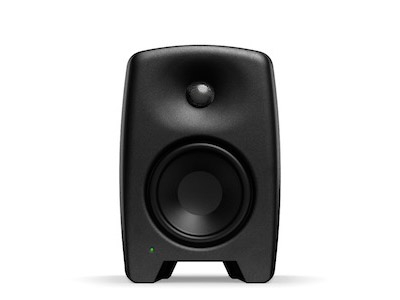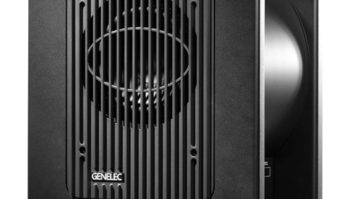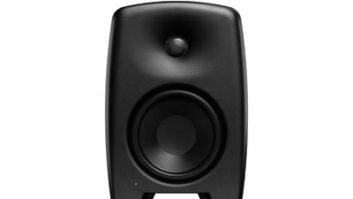
Many contemporary near-field monitors include factory-preset filters that compensate for unbalanced room tone and suboptimal placement, but the Genelec M030 might be the most flexible of the lot. And its down-firing bass ports and superbly beveled cabinet are sure to raise eyebrows.
Stealth Pro Speaker
The M030 belongs to Genelec’s new Music Creation product line, but don’t let the MI designation fool you—this is a rigorously designed monitor suitable for near-field use in a professional control room.
Weighing only 8.8 pounds and measuring a Lilliputian 10.75×7.5×7.5 inches (HxWxD), the diminutive M030 nonetheless makes a striking visual impression. The face and back baffle are rounded on the top and sides, and the top and sides of the enclosure itself are curved. (The Natural Composite Enclosure is made up of an injection-molded, 50-50 blend of Finnish wood and recycled, non-toxic polymers.) Taken with the impressive-looking Directivity Control Waveguide for the ¾-inch tweeter, I expected outstanding imaging free from diffractive effects, and I wasn’t disappointed. Two curved slots in the bottom of the cabinet serve as bass ports. Genelec explained that their down-firing orientation was chosen to preserve front-baffle real estate and simplify manufacturing.
Low-distortion, high-output Class-D amplifiers power the M030: 50 W for the 5-inch woofer and 30 W for the tweeter. The crossover sits at 3 kHz. The frequency response is specified as 58 Hz–20 kHz (-3 dB).
The M030’s power-management uses a side-chain circuit that senses activity at the input. If it detects no audio at the input for 30 minutes, it then places the monitor into standby mode.
Rear Guard
All connections and the power and filter switches are safely recessed on the M030’s rear panel. A two-prong, detachable AC cord mates with the mains input. Genelec asserts that the monitor doesn’t need a ground wire for the mains cable, as a number of alternative safety features have been engineered into the product to fully comply with EMC and FCC regulations. In combination with the M030’s automatic voltage selection for the power supply, the two-prong circuit makes for fail-safe plug-and-play operation in different countries.
Input connections are via ¼-inch/XLR combo (balanced) and RCA (unbalanced) jacks. Thankfully, the XLR connector latches. (Most other monitors don’t include this safety precaution.) Maximum published SPL is a boisterous 103 dB wide open, but a three-way switch allows you to knock the level down 10 or 20 dB. I found the -20 dB setting to offer more than enough steam. People who work in an asymmetrical room or with a digital mixer having imperfectly calibrated, fixed outputs may lament that the M030 has no trim pot for making fine level adjustments between monitors.
Two three-way filter switches bring to light the M030’s adaptability to wide-ranging rooms. The Bass Level switch provides shelving cut that starts at the crossover, slopes gently down to roughly 100 Hz and then cuts uniformly down to the low-frequency tuning point. The switch’s alternate settings yield 0, -2 or -4dB response at 100 Hz. Genelec suggests that you use the -2dB setting for free-standing placement (that is, away from walls) in a damped room or when placing the M030 on a nearby table or other reflective surface. The -4dB setting is suggested for freestanding placement in a reverberant room.
The other three-way filter switch I alluded to is simply dubbed “EQ.” Its Bass EQ setting slopes down from roughly 400 Hz to 150 Hz, below which it provides 2 dB of attenuation down to the LF cutoff. Genelec suggests using this setting in conjunction with the Bass Level’s -4dB setting if you must place the M030 in a corner. The alternative Tabletop EQ switch position remedies its namesake’s debasing influence by activating a relatively broad bell-curve filter that provides 3 dB of attenuation at 230 Hz; the filter’s effect extends more mildly down to 100 and up to 600 Hz. (The Genelec 8040 and 8050 include the same Tabletop EQ filter.) The EQ switch also has an Off setting.
By now you no doubt get the central point of this review: The M030 adapts to both live and dead rooms and placement in corners, on tabletops or near walls—everywhere but on Mars!
Listening Tests
I placed a pair of M030s on Primacoustic Recoil Stabilizers that were situated on the shelves of my Omnirax MixStation console workstation. (Recoil Stabilizers are an outstanding solution for decoupling monitors from shelves, preventing sympathetic resonance in upper-bass and low-midrange frequencies.) The front of my control room sports an Acoustic Sciences Corporation Attack Wall—a modular arrangement of tube traps that forms a continuous acoustic wall—that tightens up the bass impulse response at my mix position.
With all filters switched out, the M030s sounded very good overall and, in some ways, superb. The transient response and degree of high-frequency detail were positively outstanding. Imaging was also excellent. Low-frequency extension was admirable for such a small monitor.

I had a couple of quibbles. Background vocals, pedal steel guitar and fiddle sounded slightly understated. I also heard very slight flabbiness in the upper-bass range that made drums and bass guitar sound just a hair tubby.
Activating the Tabletop EQ opened up the sound beautifully, clearing out mud and tightening up the bass without audibly diminishing the monitors’ comparative and flattering bump in low-bass response centered at 75 Hz. Now the highs sounded absolutely airy, and drums were slammin’. BVs, steel and fiddle, however, still sounded a bit receded. I don’t want to overstate this, because the effect was subtle.
I tried activating the Bass Level filter at its -2dB setting in lieu of using the Tabletop EQ. Doing so made the M030s sound slightly warmer but less open in comparison. It sounded like the Bass Level filter didn’t cut quite so much at 200 Hz as the Tabletop EQ did, and it moderated higher frequencies in the midrange band; a supplied frequency plot corroborated what I was hearing. My preference for the Tabletop EQ notwithstanding, if the Bass Level filter had been my only available option, I would’ve been impressed with the sound it conferred. And I should note that the spectral balance at my mix position has a very slight buildup around 200 Hz (probably due to reflections off my mixer’s top surface), making the Tabletop EQ a good counterbalance. This reinforces my point that, no matter what challenges your room acoustics and equipment orientation pose, the M030 probably has at least one filter setting (or combination) that will allow it to sing in your nest.
Just for grins, I tested the M030s with my home-entertainment system, deliberately putting one monitor very near a corner and the other only one foot from the back wall. I used Genelec’s suggested filter settings for these placements and streamed “Classic Albums: Steely Dan: Aja” on Netflix. (Those of you who knew the late engineer Roger Nichols will enjoy seeing the bittersweet footage of him in this excellent documentary.) Even with such heavily compromised placement, the M030s’ spectral balance sounded fantastic (with no external equalization applied). Unfortunately, my TV can’t adjust levels at its speaker outputs, and I pined for level-trim pots for the M030.
Best of Breed?
It goes without saying that the M030 is a small monitor with limited bass extension. (Its sibling, the M040 extends bass response down to 48 Hz.) Unlike most other small near-fields on the market, however, the M030 doesn’t attempt to be what it’s not. You won’t have to deal with hyped, ballooning bass and fight to hear through attendant frequency masking in the midrange, a spectral imbalance that plagues most small near-fields because they strive too hard to sound large.
Yes, you’ll need to add either a subwoofer or a pair of full-range monitors to your setup to check that the bottom octave and a half of your mixes has the proper balance. The M030 excels where it should: giving you the all-important “small picture.” They’re a bit pricey, but the M030 is one of the best-sounding small-format near-fields I’ve heard to date.
Michael Cooper (myspace.com/michaelcooperrecording) has written over 400 articles about pro audio over the past 25 years.
PRODUCT SUMMARY
COMPANY: Genelec
PRODUCT: M030
WEBSITE:genelec.com
PRICE: $1,390/pair (list)
PROS: Sounds great. Flexible, practical filtering (monitor is adaptable to diverse rooms and setups). Combo jack latches XLR connector. Automatic voltage selection.
CONS: No level-trim pot. Pricey.
Try This
Whether you place your monitors on stands, shelves, tube traps or isolators such as Recoil Stabilizers, make sure you position them so that the front edge of each cabinet is on the forward edge of the mounting surface. Doing so will prevent reflections off the surface that would otherwise cause comb filtering at your listening position.





